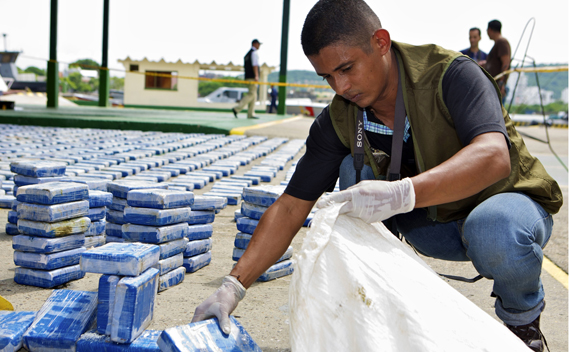Drugs and Thugs: U.S. Running to Stand Still
More on:

This week the White House released an ambitious Strategy to Combat Transnational Organized Crime. It promises a massive U.S. policy response to a burgeoning global threat, but the Internationalist feels sorry for whoever must implement it. For, President Obama’s cover letter observes—without irony— “this strategy sets out 56 priority actions.”
The strategy reminds me of the Red Queen, who told Alice in Through the Looking Glass, "It takes all the running you can do, to keep in the same place."
Still, there’s much to applaud in the strategy, beginning with its threat assessment. Transnational organized crime (TOC) has been a prime beneficiary of globalization. Once hierarchical and specialized, TOC groups are increasingly decentralized, able to hopscotch across sovereign jurisdictions and adapt products and supply chains. Their fluid and networked structure allows them to sidestep interdiction efforts and renders traditional law enforcement obsolete.
As the strategy makes clear, TOC is driving a “convergence of transnational threats” that undermine global security and prosperity. From Colombia to Afghanistan to Myanmar, insurgencies increasingly rely on illicit arms and drug revenues for financial support. Criminal syndicates foster corruption to skirt legal structures, weakening fragile states from Guatemala to Guinea-Bissau. (Actually, my latest book Weak Links devotes an entire chapter to the link between TOC and fragile states. While it is more uneven than often presumed, it is certainly a salient challenge.) Criminals and terrorists are appropriating each others’ strategies—and forming alliances. Al-Qaeda and Hezbollah support themselves through narcotics and other illicit commodities, even as WMD proliferators exploit black market routes through the Caucasus. Finally, traffickers engage in cybercrime, money laundering, and intellectual property theft, all of which undermine confidence in the global economic and financial system.
The strategy sets out 56 “priority actions,” grouped into six clusters.
- Start at Home: Too often, transnational crime has been depicted as an evil from abroad visited upon American shores. Refreshingly, the White House strategy takes a more honest approach, declaring a mission to “reduce the demand for illicit drugs in the United States, thereby denying funding to illicit trafficking organizations.” This is a laudable goal, but how this administration will succeed where others have failed remains unclear. The strategy is also less than innovative in its orthodox treatment of drug criminalization, which counterproductively increases profit margins for traffickers.
- Enhance Intelligence and Information Sharing: Following 9/11, the U.S. intelligence community shifted its overwhelming focus to counterterrorism. The administration lays out a welcome change of tack, pledging to allocate more resources towards TOC. Enhanced intelligence sharing with foreign partners, as well as among federal, state, and local law enforcement authorities, acknowledges the globalized threat, and that no agency can tackle TOC in isolation.
- Protect the Financial System and Strategic Markets: The strategy also acknowledges TOC groups’ infiltration into legitimate commerce and how it undermines confidence in financial systems and the global economy. To address the threat, the Obama administration commits the U.S. government to monitor “strategic and emerging markets,” alert businesses if they are threatened by criminal enterprises, and design safeguards to protect investments. The strategy also outlines a special focus on combating cybercrime and intellectual property right (IPR) violations, as well as designating foreign TOC threats and their government supporters. These concrete goals are promising, but they will be truly effective only if they are implemented multilaterally—and broadly enough for commercial actors to regain confidence.
- Strengthen Interdiction, Investigations, and Prosecutions: Combating transnational organized crime requires providing law enforcement officials with innovative tools. To this end, the strategy envisions a new executive order to block property of major TOC groups, a presidential proclamation barring entry into the US of designated TOC targets, an augmented reward program leading to the arrest and conviction of major TOC figures, and a raft of legislative proposals providing new statutory authorities “to investigate, interdict, and prosecute the activities of top transnational criminal networks.” Expanding these executive branch authorities is critical, but it will require careful negotiations with relevant congressional committees.
- Disrupt Drug Trafficking and Its Facilitation of Other Transnational Threats: Forty years after it was declared by President Nixon, the “War on Drugs” lives on. The new strategy recommits the United States to working with other countries to “support for drug crop reduction, promotion of alternative livelihoods, and partner nation capacity building”—including “complementary and comprehensive assistance programs across the prevention, intervention, and enforcement spectrum.” Alas, little here is new. Past experience suggests that successes in one country (as in Colombia, where coca production declined 15% in 2010), are often offset by production surges elsewhere (most recently, in Peru, which now rivals Colombia as a producer)—a phenomenon scholars of the drug trade term “the balloon effect.”
- Build International Capacity, Cooperation, and Partnerships: Finally, the strategy promises a “renewed commitment to multilateral diplomacy,” as well as efforts to build the capacity of “nations that have the will to fulfill their international law enforcement commitments but lack the necessary means.” The document is disappointingly vague, however, on what form this renewed multilateralism will take—merely offering a laundry list of global and regional institutions with which the United States will continue to work. It is also silent on how the United States will address those countries—from Myanmar to Venezuela—that have the capacity but lack the will to attack TOC.
In the end, the most daunting task outlined by the strategy may be interagency coordination within the United States—and among financial institutions, law enforcement agencies, and national security apparatuses across the world. The strategy is an essential step in the battle against TOC, if only because it updates national policy by acknowledging how much the threat has evolved. It might not stymie TOC, but at least we’re running to stand still instead of falling behind.
More on:
 Online Store
Online Store